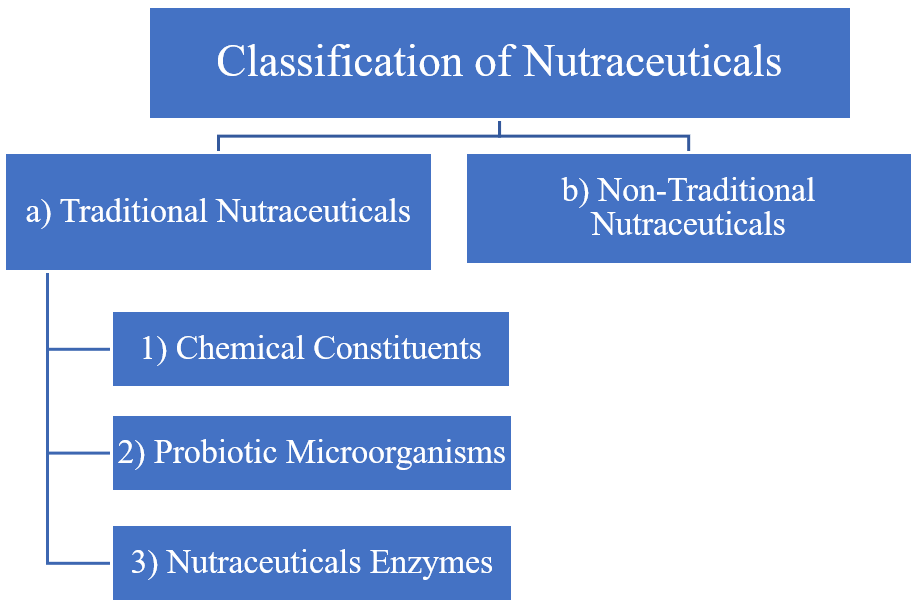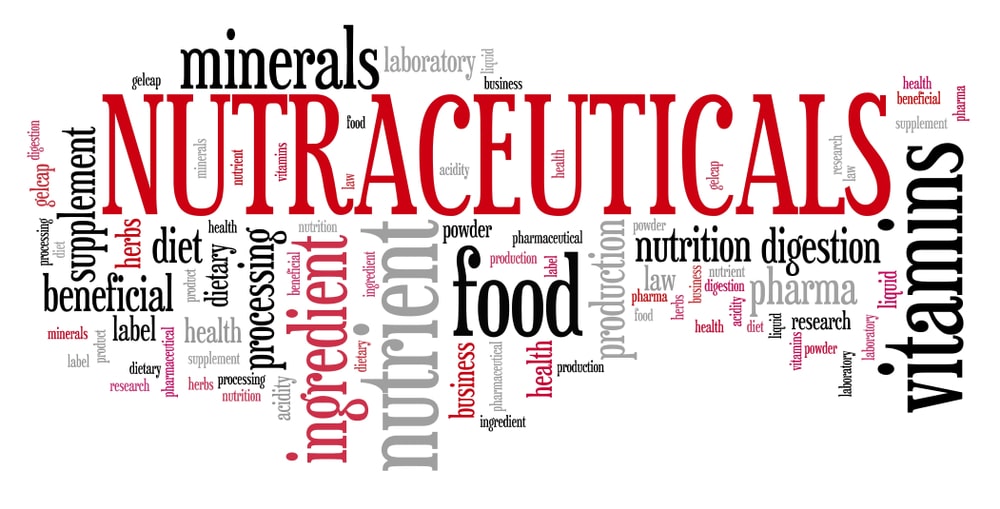Classification of Nutraceuticals: A nutraceutical is a food or food component that claims to have health benefits, including treatment and prevention of disease. In 1989, Stephen DeFelice, M.D., derived the term “nutraceutical” from “nutrition” and “pharmaceutical.” It’s used as a marketing term.
Glucosamine, chondroitin, and MSM are popular dietary supplements that are touted as beneficial for joint health.
As defined by Congress in the Dietary Supplement Health and Education Act, which became law in 1994, a dietary supplement is a product (other than tobacco) that is intended to supplement the diet; contains one or more dietary ingredients (vitamins, minerals, herbs, amino acids, and other substances); is intended to be taken orally, and is labeled on the front panel as being a dietary supplement.

Nutraceuticals are categorized based on foods available in the market
- Traditional nutraceuticals
- Non-traditional nutraceuticals
1. Traditional nutraceuticals
Table of Contents
Traditional nutraceuticals are simply natural with no changes to the food. Food contains several natural components that deliver benefits beyond basic nutrition, such as lycopene in tomatoes, omega-3 fatty acids in salmon, or saponins in soy. They are grouped based on
1. Chemical Constituents
a Nutrients
b) Herbals
c) Phytochemicals
2. Probiotic Microorganisms
3. Nutraceutical Enzymes
1. Chemical Constituents
a) Nutrients
Substances such as vitamins, minerals, amino acids, and fatty acids with established nutritional functions. Most vegetables, wholegrain cereals, dairy products, fruits, and animal products such as meat, poultry, contain vitamins and help cure heart diseases, stroke, cataracts, osteoporosis, diabetes, and cancer. Minerals found in the plant, animal, and dairy products are useful in osteoporosis, anemia and build strong bones, teeth, muscles, improve nerve impulses and heart rhythm. Flaxseed and salmon contain fatty acids omega-3 PUFAS, and are potent controllers of the inflammatory processes, maintenance of brain function, and reduce cholesterol deposition.
b) Herbals
Nutraceuticals hold a great promise to improve health and prevent chronic diseases with the help of herbals. Some examples are willow bark (Salix nigra), having an active component as salicin, which is anti-inflammatory, analgesic, antipyretic, astringent, and antiarthritic. Parsley (Petroselinum cripsum) contains flavonoids (apiol, psoralen) and is diuretic, carminative and antipyretic. Peppermint (Mentha piperita) contains menthol as an active component and cures a cold and flu. Lavender (Lavandula angustifolia) contains tannin which helps cure depression, hypertension, stress, cold, cough, and asthma. Cranberries (Vaccinium erythrocarpum) contain proanthocyanidin and are found to be useful in cancer, ulcers, and urinary tract infections.
c) Phytochemicals
Phytochemicals are one class of nutraceuticals. They are classified based on the chemical name given according to their phytochemical properties. For example, Carotenoids (Isoprenoids) found in various fruits, vegetables, and egg yolk, are anti-carcinogenic, boost natural killer immune cells, and protect cornea against UV light. Legumes (chickpeas and soybeans), grains, palm oil contain non-carotenoids, which remove cholesterol and are anti-carcinogenic. Flavonoid polyphenolics are found in berries, fruits, vegetables, and legumes, which are potent antioxidants, phytoestrogens, prevent breast cancer, prostate cancer, and control diabetes. Non-flavonoid polyphenolics are present in dark grapes, raisins, berries, peanuts. turmeric roots are strong anti-inflammatory, anti-oxidants, and effective anti-clotting agents and reduce cholesterol. Phenolic acids, found in blueberries, tomatoes, and bell peppers having antioxidant activity, reduce mutagenicity of polycyclic aromatic hydrocarbons. Seeds of Barbarea verna, broccoli contain isothiocyanates (glucosinolates) and have antitumorigenic activity.
2. Probiotic Microorganisms
The scientific interest in probiotics boosted from the work of Metchnikoff to transform the toxic flora of the large intestine into a host-friendly colony of Bacillus bulgaricus was found by Hord. Probiotics mean for life and are defined as live microorganisms, which when consumed in adequate amounts, confer a health effect on the host. They are friendly bacteria that promote healthy digestion and absorption of some nutrients. They act to crowd out pathogens, such as yeasts, other bacteria, and viruses that may otherwise cause disease and develop a mutually advantageous symbiosis with the human gastrointestinal tract. They have an antimicrobial effect through modifying the microflora, preventing adhesion of pathogens to the intestinal epithelium, competing for nutrients necessary for pathogen survival, producing an antitoxin effect, and reversing some of the consequences of infection on the intestinal epithelium, such as secretory changes and neutrophil migration. Probiotics can cure lactose intolerance by the production of the specific enzyme (ß-galactosidase) that can hydrolyze the offending lactose into its component sugars. Sources of probiotic microorganisms are mentioned (Table1).
Table 1: Sources of probiotic microorganisms
| Milk | Yogurt | Fermented products | Human breast milk | GI tract | Vegetables/ grains/ fruits |
| Lactobacillus acidophilus L. lactis | L.delbrueckii subp bulgaricus | L.cellobiosus L. curvatus L. casei L.fermentum. L. helviticus L. farciminis | L reuteri L. salivarius | L. gassert L. johnsoni | L. brevis L plantarum |
| Bifido bacterium adolescentis | B.thermophilum B. animalis | B.infantis B.longum B. breve, B. lactis | |||
| Propioni bacterium freudenreichli | Streptococcus thermophilus | Escherichia coli Nissle 1917 | Leuconstoc mesenteroides | ||
| S. cerevisiae, S. boulardii Mushrooms |
3. Nutraceutical Enzymes
Enzymes are an essential part of life, without which our bodies would cease to function. Those people who are suffering from medical conditions such as hypoglycemia, blood sugar disorders, digestive problems, and obesity, eliminate the symptoms by enzyme supplements to their diet. These enzymes are derived from microbial, plant, and animal sources (Table 2).
Table 2: List of nutraceutical enzymes from microbes, plants, and animals
| Microbial Enzymes/source | Plant Enzymes/source | Animal Enzymes/source |
| Hemicellulase (microorganisms and mushrooms) | Hemicellulase (plant walls) | OxBile (ox) |
| Catalase | Pectinase (cell wall) | Pancrelipase (pancreatic juice) |
| Amyloglucosidase (ascomycetes) | α-Galactosidase (beans, cabbage, Brussels sprouts, broccoli, asparagus, other vegetables, and whole grains) | Trypsin (pancreatic juice) |
| Glucoamylase (A. niger, Saccharomycopsis fibuligera) | β -Amylase (higher plants) | Chymotrypsin (all classes of vertebrates) |
| Cellulase (all living cells) | Bromelain (pineapple) | Pepsin (animals tracheal secretions) |
| Invertase-Sucrase (yeast) | Biodiastase (soybean) | Lysozyme (saliva, tears, egg white, and many animal fluids) |
| Lactase-ß-Galactosidase (bacteria) | Glucoamylase (callus and suspension cultures of sugar beets (Beta vulgaris L.) as well as in mature roots) | α-Amylase (saliva) |
2. Non-traditional nutraceuticals
Non-traditional nutraceuticals are artificial foods prepared with the help of biotechnology. Food samples contain bioactive components which are engineered to produce products for human- wellness. They are arranged into
a) Fortified nutraceuticals
b) Recombinant nutraceuticals
a) Fortified nutraceuticals
It constitutes fortified food from agricultural breeding or added nutrients and/or ingredients. e.g. orange juice fortified with calcium, cereals with added vitamins or minerals, and flour with added folic acid. Some examples are milk fortified with cholecalciferol used in vitamin D deficiency Prebiotic and probiotic fortified milk with Bifidobacterium lactis HN019 used in diarrhea, respiratory infections, and severe illnesses, in children. Banana fortified using soybean ferritin gene in iron deficiency.
b) Recombinant nutraceuticals.
Energy-providing foods, such as bread, alcohol, fermented starch, yogurt, cheese, vinegar, and others are produced with the help of biotechnology. The production of probiotics (Table 4) and the extraction of bioactive components by enzyme/fermentation technologies as well as genetic engineering technology are achieved through biotechnology.
Table 3: Product produced by recombinant microorganisms
| Source | Enzyme | Products |
| Acetobacter xylinum | B-glucuronidase | Kombucha beverage |
| Escherichia coli K-12 | Chymosin | Milk-coagulated products |
| Fusarium venenatum | Xylanase | Increased bran solubilization |
| Aspergillus oryzae | Esterase-lipase, Aspartic proteinase, Glucose oxidase, Laccase, Lipase, Pectin esterase, | Alcoholic beverages (Sake, koji) |
| Saccharomyces cerevisiae | Stilbene synthase and 4 couraroyl-CoA | Resveratrol |
| Spirulina Pacifica | Indoleamine 2,3-dioxygenase (IDO) | Increased hemoglobin |
Table 4: Product produced by recombinant plants
| Source | Enzyme | Products |
| Gold kiwifruit | Iron | High level of Ascorbic acid, carotenoids lutein, and zeaxanthin |
| Potatoes | Protein | Tuber-specific expression of a seed protein, AmA1 (Amaranth Albumin 1) |
| Golden mustard | Vitamin A | Soybean ferritin gene |
| Multivitamin corn | Multivitamin | Vitamins ß-carotene corn (Zea mays) phytoene synthase (psyl) cDNA), ascorbate (rice dehydroascorbate reductase (dhar) cDNA), and folate (E. coli folE gene encoding GTP cyclohydrolase (GCHI) |
| Maize | Vitamin A (retinol) | Bacterial genes crtB and crtl |
| Tomato | Folate | |
| Golden rice | Vitamin A (retinol) | Two daffodil genes bacterial gene |
| Iron rice | Iron deficiency | Soybean ferritin gene |
Table 5: Product produced by recombinant animals.
| Source | Enzyme | Products |
| Fermented soya milk | Calcium deficiency | Lactobacillus acidophilus American Type Culture Collection (ATCC) 4962 |
| Cattle | Human lysozyme | rHLZ expression vector pBC2 HLY-NEOR |
| Yogurt | Probiotics microorganism | Bifidobacterium lactis Bb-12 and Lactobacillus acidophilus LA-5 |
| Cows | Lactoferrin deficiency | Recombinant human lactoferrin (rhLf) |
Make sure you also check our other amazing Article on : Primary Health Center
